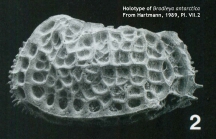| Introduction | | Species lists | | Search taxa | | Taxon tree | | Literature | | Distributions | | Statistics | | Editors | | Match taxa | | Webservice | | Log in |
Ostracoda taxon detailsBradleya antarctica Hartmann, 1989
391269 (urn:lsid:marinespecies.org:taxname:391269)
accepted
Species
marine,
recent only
Hartmann, G. (1992). Antarktische benthische Ostracoden. VIII. Auswertung der Reise der “Meteor” (Ant. 11/4) in die Gewässer um Elephant Island und der Antarktischen Halbinsel. <em>Helgoländer Meeresuntersuchungen.</em> 46(4): 405-424., available online at https://doi.org/10.1007/bf02367207 [details] Available for editors
Holotype ZMH ZIM K-33868
Holotype ZMH ZIM K-33868 [details]
Description Males and females do not fundamentally differ in shell structure. In the subadult male, the mesh sculpture was not as...
Description Males and females do not fundamentally differ in shell structure. In the subadult male, the mesh sculpture was not as pronounced as in the male, and the spines along the shell edge were weaker. The sculpture features a robust mesh pattern, with only one rib parallel to the edge on the ventral side, a horizontal rib running through the center of the shell, and the ventral rib standing out prominently. The ventral side is covered with many short spines, while the dorsal side has fewer, longer spines. Edge channels are numerous! The surface channels are sparse and simple. The interior ridge protrudes strongly in the interior view. The hinge is robustly amphidont. The hinge consists of a vertical row of four, with two round scars in front. The soft bodies of both males and females were poorly preserved, but no significant differences seem to arise compared to A. polycyca. The male copulatory organ features a large, distally rounded appendage with a similarly rounded leaf-shaped structure inside. The capsule is distinctly divided into two almost equal-sized capsules. The transverse bridge forms the sperm pump. From the complex chitin bridge, a thick, rapidly tapering, curved mating tube arises. [details] Etymology Antarctica, after the collecting locality.
Etymology Antarctica, after the collecting locality. [details]
Brandão, S.N.; Antonietto, L.S; Nery, D.G.; Pereira, J.S.; Praxedes, R.A.; Santos, S.G.; Karanovic, I. (2024). World Ostracoda Database. Bradleya antarctica Hartmann, 1989. Accessed at: https://www.marinespecies.org/ostracoda/aphia.php?p=taxdetails&id=391269 on 2024-10-05
Date action by
original description
Hartmann, G. (1992). Antarktische benthische Ostracoden. VIII. Auswertung der Reise der “Meteor” (Ant. 11/4) in die Gewässer um Elephant Island und der Antarktischen Halbinsel. <em>Helgoländer Meeresuntersuchungen.</em> 46(4): 405-424., available online at https://doi.org/10.1007/bf02367207 [details] Available for editors
basis of record Hartmann G. (1997). Antarktische und subantarktische Podocopa (Ostracoda). Synopses of the Antarctic Benthos. Koeltz Scientific Books, Koenigstein, 355. [details]  Present Present  Inaccurate Inaccurate  Introduced: alien Introduced: alien  Containing type locality Containing type locality
Holotype ZMH ZIM K-33868 [details]
From editor or global species database
Description Males and females do not fundamentally differ in shell structure. In the subadult male, the mesh sculpture was not as pronounced as in the male, and the spines along the shell edge were weaker. The sculpture features a robust mesh pattern, with only one rib parallel to the edge on the ventral side, a horizontal rib running through the center of the shell, and the ventral rib standing out prominently. The ventral side is covered with many short spines, while the dorsal side has fewer, longer spines. Edge channels are numerous! The surface channels are sparse and simple. The interior ridge protrudes strongly in the interior view. The hinge is robustly amphidont. The hinge consists of a vertical row of four, with two round scars in front. The soft bodies of both males and females were poorly preserved, but no significant differences seem to arise compared to A. polycyca. The male copulatory organ features a large, distally rounded appendage with a similarly rounded leaf-shaped structure inside. The capsule is distinctly divided into two almost equal-sized capsules. The transverse bridge forms the sperm pump. From the complex chitin bridge, a thick, rapidly tapering, curved mating tube arises. [details]Etymology Antarctica, after the collecting locality. [details] |

